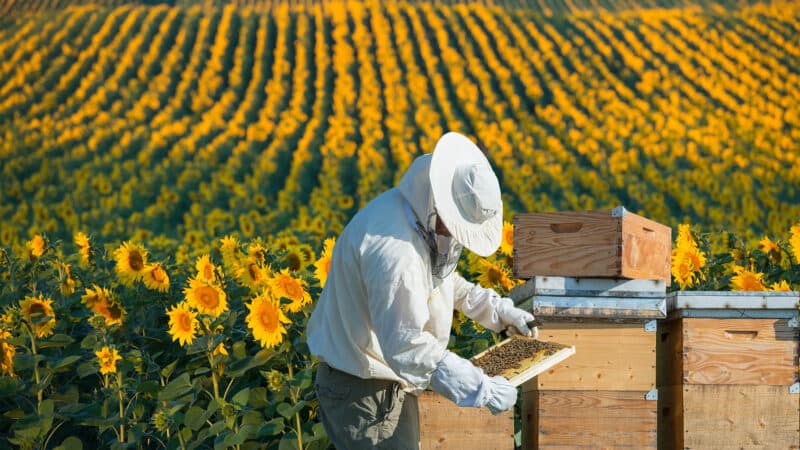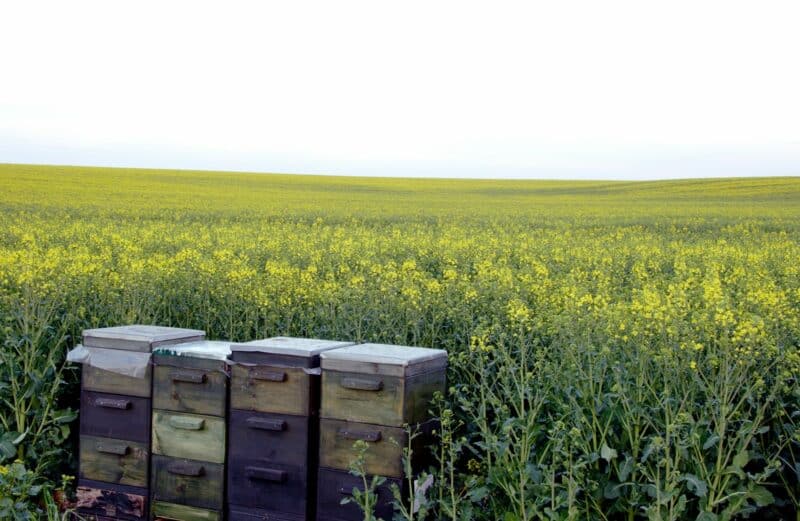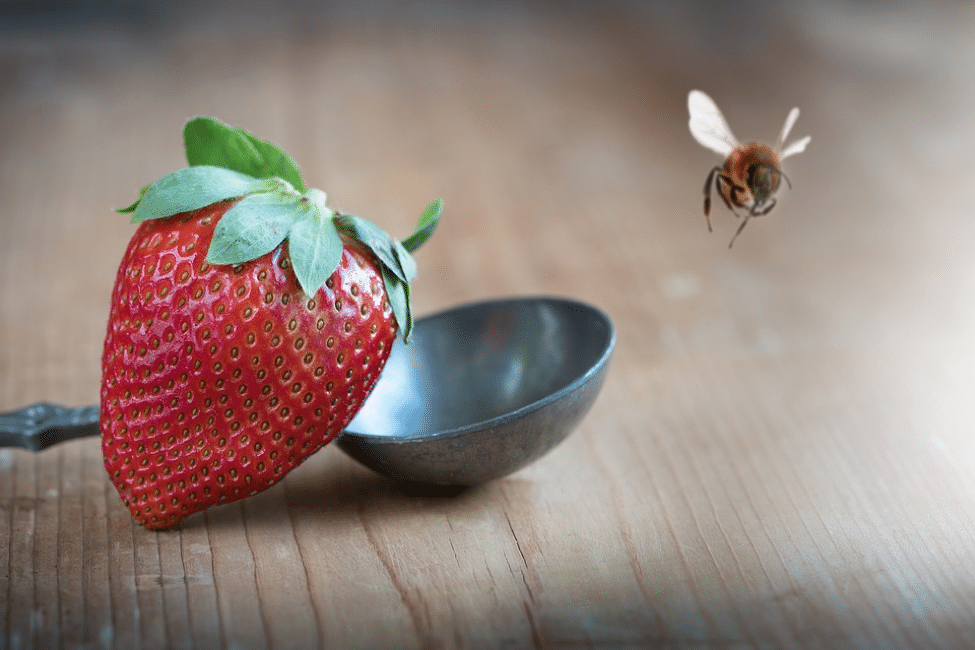First version written by Christy Erickson, guest blogger and the creator of SavingOurBees.org.
Updated in 2023 by Elsa Scott
Contents:
- Introduction to Bees and Agriculture
- Bees and Agriculture: Money Talks
- Bees and Agriculture: Key Facts and Figures
- What You Can Do To Help
- FAQs
Strawberries, apples, watermelon: we get these wonderful fruits, and other delicious foods and countless resources, through the help of bees. Believe it or not, these tiny animals are a huge influence on the agriculture that produces our food supply. However, too many bees are disappearing – and with fewer bees, the impact on our food supply could be devastating.
Yes, bees really are that important. With more than 700 bee species heading towards extinction, this is a serious problem. Thankfully, there are a few ways you can help support bees. First, it’s important to understand exactly why bees are so important to agriculture.
Introduction to Bees and Agriculture
Crops don’t just magically grow each year. The plants need to be fertilized with pollen, which is why bees are so important. Bees are responsible for pollinating over one-third of the food supply. Pollinators improve the quality and quantity of farmers’ crop yields. If a plant has been well pollinated, it will produce larger, tastier, and more uniform fruits. They’re so essential that farmers rent honey bee hives from beekeepers to help pollinate crops of stone fruits, berries, almonds, pumpkins, and even alfalfa, which is used to feed cattle.
While it’s easy to picture fruits and vegetables being products of pollination, we can’t forget about the more indirect products of equal importance. More than half of the world’s diet of fats and oils come from animal-pollinated plants like canola and sunflowers, and the meat industry relies upon pollination to ensure adequate food supplies for the animals.
Although there are some other animals that pollinate, honey bees are by far the most widespread and effective; they are the most frequent single species of pollinator for crops worldwide. Pollination is the most critical factor in successful crop production, and because honey bees are easily managed and transported by humans, they have become a staple tool in agriculture across the globe.
The loss of bees spells disaster for the global food supply. At first, supplies of these foods could dwindle, driving up the price. Eventually, grocery stores could completely run out of these healthy foods because there are no new crops growing.
Honey Bees and Agriculture: Money Talks

If we’re talking about bees and agriculture, we also have to talk about the economics of the agriculture industry. Honey bees pollinate $15 billion worth of crops in the United States each year, including more than 130 types of fruits, nuts, and vegetables.
Aside from food production, honey bees contribute to the economy through the commodification of honey, beeswax, propolis, and royal jelly. According to the U.S. Department of Agriculture’s National Agriculture Statistics Service, honey bees made 157 million pounds of honey in 2019. With the cost of honey at $1.97 per pound, that’s a value of a little over $339 million, and the global honey market value is expected to reach $13.6 billion by 2030 (according to Grand View Research). In 2017, the US honey industry was responsible for more than 22,000 jobs.
Bees and Agriculture: Key Facts and Figures
- Three out of four crops across the globe producing fruits or seeds for human use as food depend, at least in part, on pollinators.
- Improving pollinator density and diversity boosts crop yields – pollinators affect 35 percent of global agricultural land, supporting the production of 87 of the leading food crops worldwide.
- Pollination-dependent crops are five times more valuable than those that do not need pollination.
- The price tag of global crops directly relying on pollinators is estimated to be between $235 and $577 billion a year.
- If you factor in the medicines, biofuels, fibers, raw materials, and products bees and other pollinators provide, globally, pollination services are likely worth more than three trillion dollars.
- The volume of agricultural production dependent on pollinators has increased by 300 percent in the last 50 years.
What You Can Do To Help

Pollinator Paradise
So what can you do to help protect bees and agriculture, ensuring our continued food supply? You can start by creating a bee-friendly garden. Whether you create an expansive garden in your backyard or just place a few pots to your patio, adding flowering plants to your outdoor space gives bees a more diverse supply of nectar and pollen which in turn helps them thrive. If you’re not sure where to start when it comes to gardening, check out this article.
Here are a few tips to start out:
- Choose plants native to your area. And it doesn’t need to be just flowers, since many fruit and vegetable plants produce flowers to reproduce.
- Create groups of the same plant – called planting in “drifts” to make it easier for bees to find them.
- Provide a source of water. Bees have to drink water like all animals, so a little puddle near the garden will attract more.
- Go with plants that bloom at different times of the year. This will provide a food source for bees throughout the part of the year they’re active.
While a great bee-friendly garden will have at least one square yard of plants, that’s not absolutely necessary. If you live in an apartment, for example, you can add some flowers to a window box or set some pots outside. Even just a few flowering plants can help.
Go Organic
Once you have your garden in place, there are a few other ways you can help bees and the food supply. A great way to support the health of pollinators is by minimizing your chemical lawncare. Limiting or eliminating pesticides creates a safer environment for the bee population in your area.
You can also buy more organic foods. Organic foods are not treated with any pesticides. When you support local organic farmers, you make it more attractive financially for other farmers to skip pesticides and save more bees. Seek out hyper-local produce from farmer’s markets in your town.
FAQS
Q: Why are bees important to agriculture?
A: Honey bees provide the critical ecosystem service of pollination, which is what allows crops to grow.
Q: How much do bees contribute to agriculture?
A: Honey bees pollinate $15 billion worth of crops in the United States each year, including more than 130 types of fruits, nuts, and vegetables.
Q: What crop is most dependent on bee pollination?
A: Some crops, including blueberries and cherries, are 90% dependent on honey bee pollination. Almonds are entirely dependent on honey bees for pollination.




